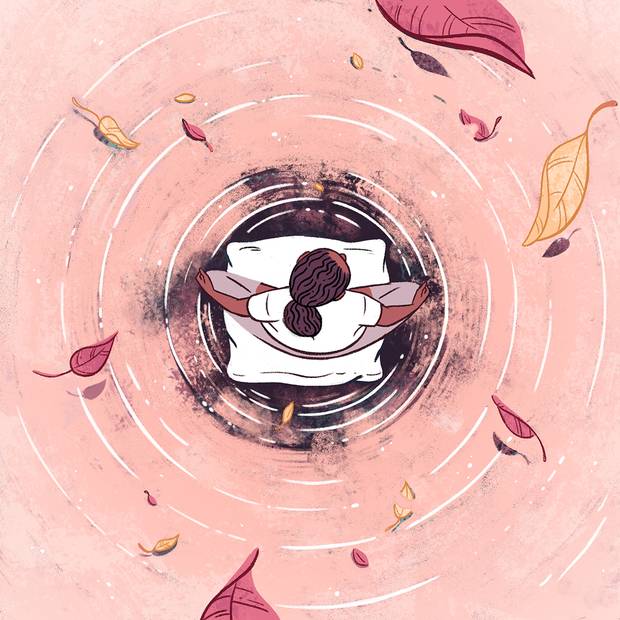Facts & Arguments is a daily personal piece submitted by readers. Have a story to tell? See our guidelines at tgam.ca/essayguide.
Three years ago, at the age of 36, I had a sweet, lively two-year-old, a beautiful, ginger-haired five-month-old and a loving husband who was going to manage the bills for a few years while I stayed home to nurture our family. Having lost my mom to cancer just two years before, I was hungry for domestic life. I wanted to do crafts, bake cookies and leave no hug unrequited.
At first, I didn't suspect that the hard area on the side of my breast was anything other than a blocked milk duct. Until one night, in between bleary-eyed diaper changes and feeding sessions, I had a dream that the hardness was foreign, that it shouldn't be there. It wasn't menacing; I dreamed it was a smooth stone, like the kind you would search for when skipping stones across a lake. But I made an appointment with my family doctor the next morning anyway.
A few weeks later, my husband and I sat side-by-side in a stark room in the basement of Toronto's Princess Margaret Hospital watching a well-intentioned radiologist fuss with the paper covering the examination table while she told us that the cancer had spread to my spine. I had learned two weeks before that I had breast cancer, but she confirmed my greatest fear about the sore back I had been trying to heal with a strict ab regime. The next moment in this macabre tale is of my oncologist, who told me that I would be fighting to keep the cancer "at bay" for the rest of my life because "the horse had already left the barn." Chemo was to start on Tuesday.
That was it. Where are the cameras? I have terminal cancer, everyone. Stage IV, metastatic breast cancer. Incurable. I soon learned that the median survival is three years. We went directly to the nearest dive bar and summoned our closest friends.
I stopped breastfeeding and our little family of four moved to a new home on the west side of the city. It was a tragic twist to my precancer storyline. One that had begun with aspirations of landing in a tidy little home in a desirable school district – a house with a driveway on a tree-lined street. My husband and I were shell-shocked, broken souls surrounded by reminders of a beautiful life that now belonged to an alternate reality.
The cancer retreated hastily in response to chemo and I managed to laugh occasionally. Still, taking a sleeping pill at 9:00 p.m. was the best part of my day. I didn't know how to live with my new reality – with my mortality. Before being diagnosed, I had worked as a lawyer, and now, my profession was to find a way to live without fear (even with joy?) in the face of death.
I started meditating and devouring books on mindfulness and Buddhism. Sitting on that meditation cushion in my bedroom, and sometimes in the presence of others at a local meditation centre, I literally shook with fear. I was on a plane that was hurtling toward the ground. I sometimes doubled over, sobbing as I imagined the gory details of my family hovering over my corpse. Or seeing my waxy face in a hospital bed. Or, I would envision myself as a gaunt figure lying upstairs in bed, staring out the window and listening to the sounds of my children playing in the backyard. Playing without their mama.
I continue to sit with my darkest emotions and welcome them in the hopes that we can become friends. I have sat on my cushion day after day, for three years. Each day brings new emotions: anger, gratitude, boredom, fatigue, elation. As they arise, I try to simply notice how each of them feels in my body, observe the thoughts that accompany them and then, instead of getting caught up, simply rest in the reality of the immediate moment and be a human sitting on a cushion on this planet.
Time has passed and it has smoothed the sharp edges of my reality, but something more profound has happened. At some point, through the practice of meditation, I started to see beauty where I hadn't seen it before. Instead of jumping from one anxious moment to the next, I started to notice the space between those points. In between, there was contentment. Even joy.
No teacher or book could tell me exactly how meditation worked; they could only point to an answer that I had to experience for myself. Now, at times, I can see the answer for myself and I can point my finger for others. That finger doesn't point to a misty place in the clouds with tinkling wind chimes.
For me, that finger points to many simple places. Sometimes, it points to a snowy street corner, where I am waiting for the school bus, trying to settle down my rambunctious five year old, arranging the blanket covering her sister in the stroller. I can sometimes enjoy that moment, even though I'm acutely aware that the time of my death is much closer than I would like. I can step back from my thoughts; feel my feet, feel my chest rising and falling as I breathe and experience the subtle joy of standing on a street corner in the winter sunshine waiting for a school bus with two precious little girls. Sometimes.
It's as simple and miraculous as that.
Amy Peasgood lives in Toronto.
